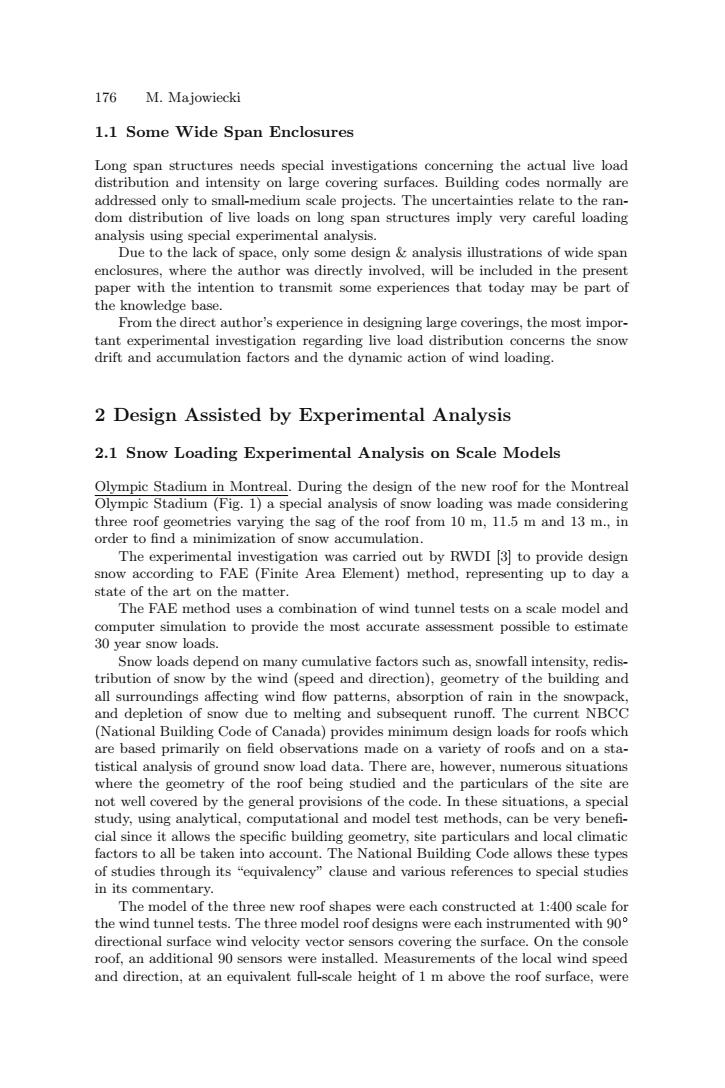正在加载图片...

176 M.Majowiecki 1.1 Some Wide Span Enclosures Long span structures needs special investigations concerning the actual live load distribution and intensity on large covering surfaces.Building codes normally are addressed only to small-medium scale projects.The uncertainties relate to the ran- dom distribution of live loads on long span structures imply very careful loading analysis using special experimental analysis. Due to the lack of space,only some design analysis illustrations of wide span enclosures,where the author was directly involved,will be included in the present paper with the intention to transmit some experiences that today may be part of the knowledge base. From the direct author's experience in designing large coverings,the most impor- tant experimental investigation regarding live load distribution concerns the snow drift and accumulation factors and the dynamic action of wind loading. 2 Design Assisted by Experimental Analysis 2.1 Snow Loading Experimental Analysis on Scale Models Olympic Stadium in Montreal.During the design of the new roof for the Montreal Olympic Stadium(Fig.1)a special analysis of snow loading was made considering three roof geometries varying the sag of the roof from 10 m,11.5 m and 13 m.,in order to find a minimization of snow accumulation. The experimental investigation was carried out by RWDI [3]to provide design snow according to FAE (Finite Area Element)method,representing up to day a state of the art on the matter. The FAE method uses a combination of wind tunnel tests on a scale model and computer simulation to provide the most accurate assessment possible to estimate 30 year snow loads. Snow loads depend on many cumulative factors such as,snowfall intensity,redis- tribution of snow by the wind (speed and direction),geometry of the building and all surroundings affecting wind flow patterns,absorption of rain in the snowpack, and depletion of snow due to melting and subsequent runoff.The current NBCC (National Building Code of Canada)provides minimum design loads for roofs which are based primarily on field observations made on a variety of roofs and on a sta- tistical analysis of ground snow load data.There are,however,numerous situations where the geometry of the roof being studied and the particulars of the site are not well covered by the general provisions of the code.In these situations,a special study,using analytical,computational and model test methods,can be very benefi- cial since it allows the specific building geometry,site particulars and local climatic factors to all be taken into account.The National Building Code allows these types of studies through its "equivalency"clause and various references to special studies in its commentary. The model of the three new roof shapes were each constructed at 1:400 scale for the wind tunnel tests.The three model roof designs were each instrumented with 90 directional surface wind velocity vector sensors covering the surface.On the console roof,an additional 90 sensors were installed.Measurements of the local wind speed and direction,at an equivalent full-scale height of 1 m above the roof surface,were176 M. Majowiecki 1.1 Some Wide Span Enclosures Long span structures needs special investigations concerning the actual live load distribution and intensity on large covering surfaces. Building codes normally are addressed only to small-medium scale projects. The uncertainties relate to the random distribution of live loads on long span structures imply very careful loading analysis using special experimental analysis. Due to the lack of space, only some design & analysis illustrations of wide span enclosures, where the author was directly involved, will be included in the present paper with the intention to transmit some experiences that today may be part of the knowledge base. From the direct author’s experience in designing large coverings, the most important experimental investigation regarding live load distribution concerns the snow drift and accumulation factors and the dynamic action of wind loading. 2 Design Assisted by Experimental Analysis 2.1 Snow Loading Experimental Analysis on Scale Models Olympic Stadium in Montreal. During the design of the new roof for the Montreal Olympic Stadium (Fig. 1) a special analysis of snow loading was made considering three roof geometries varying the sag of the roof from 10 m, 11.5 m and 13 m., in order to find a minimization of snow accumulation. The experimental investigation was carried out by RWDI [3] to provide design snow according to FAE (Finite Area Element) method, representing up to day a state of the art on the matter. The FAE method uses a combination of wind tunnel tests on a scale model and computer simulation to provide the most accurate assessment possible to estimate 30 year snow loads. Snow loads depend on many cumulative factors such as, snowfall intensity, redistribution of snow by the wind (speed and direction), geometry of the building and all surroundings affecting wind flow patterns, absorption of rain in the snowpack, and depletion of snow due to melting and subsequent runoff. The current NBCC (National Building Code of Canada) provides minimum design loads for roofs which are based primarily on field observations made on a variety of roofs and on a statistical analysis of ground snow load data. There are, however, numerous situations where the geometry of the roof being studied and the particulars of the site are not well covered by the general provisions of the code. In these situations, a special study, using analytical, computational and model test methods, can be very benefi- cial since it allows the specific building geometry, site particulars and local climatic factors to all be taken into account. The National Building Code allows these types of studies through its “equivalency” clause and various references to special studies in its commentary. The model of the three new roof shapes were each constructed at 1:400 scale for the wind tunnel tests. The three model roof designs were each instrumented with 90◦ directional surface wind velocity vector sensors covering the surface. On the console roof, an additional 90 sensors were installed. Measurements of the local wind speed and direction, at an equivalent full-scale height of 1 m above the roof surface, were